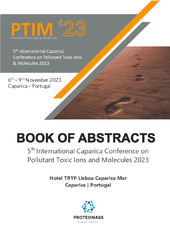Приказ основних података о документу
Biosorption of brilliant green using Myriophyllum spicatum immobilized in alginate beads
| dc.contributor | Lodeiro, Carlos | |
| dc.creator | Milojković, Jelena | |
| dc.creator | Antanasković, Anja | |
| dc.creator | Šoštarić, Tatjana | |
| dc.creator | Jekić, Jelena | |
| dc.creator | Adamović, Vladimir | |
| dc.creator | Lopičić, Zorica | |
| dc.date.accessioned | 2024-01-09T12:41:23Z | |
| dc.date.available | 2024-01-09T12:41:23Z | |
| dc.date.issued | 2023 | |
| dc.identifier.isbn | 978-989-35197-0-7 | |
| dc.identifier.uri | https://ritnms.itnms.ac.rs/handle/123456789/1210 | |
| dc.description.abstract | Over the past few decades, synthetic dye pollution of water has emerged as one of the most significant environmental problems [1]. The toxic cationic dye brilliant green (BG), is commonly used in the dyeing of textiles, rubber, paper, printing, and other dye-based industries [2]. Cationic dyes are more poisonous than anionic dyes. Even at modest concentrations (1 mg/L), cationic dyes, like BG, can be extremely harmful to human health [3]. To protect the environment, it is essential to remove this dye from wastewater [4]. For the removal of dyes from the effluents, a number of methods of treatment have been applied, including adsorption, oxidation-ozonation, biological treatment, coagulation-flocculation, and membrane process [5]. Biosorption has been shown to be an efficient, affordable technique for removing synthetic dyes from wastewater, particularly when using biowaste and agricultural byproducts as the biosorbent [6]. In this study, biosorbent prepared from submerged aquatic weed Myriophyllum spicatum immobilized in alginate beads MsA was used for removal of toxic dye, brilliant green, from aqueous solutions in batch system. Before and after BG biosorption, different functional groups present on MsA beads were examined using Fourier transform infrared spectroscopy (FTIR) analysis. The functional groups involved in the biosorption process were: carboxyl, carbonyl and hydroxyl. Three reaction and one diffusion based kinetic models were applied on kinetic data removal BG on MsA. Kinetic modeling confirms the pseudo second-order model by showing that chemisorption, which involves ionic interactions, is the rate-limiting phase [7]. Intraparticle diffusion is not a sole rate-controlling step and biosorption process might be of complex mechanism included of both surface biosorption and intraparticle diffusion. The adsorption capacity was 19.7 mg/g. These findings support the use of cost-effective and sustainable immobilized cosmopolitan invasive aquatic weed for the decolorization of industrial wastewater. | sr |
| dc.language.iso | en | sr |
| dc.publisher | PROTEOMASS Scientific Society | sr |
| dc.relation | info:eu-repo/grantAgreement/MESTD/inst-2020/200023/RS// | sr |
| dc.rights | openAccess | sr |
| dc.source | 5th International Caparica Conference on Pollutant Toxic Ions and Molecules 2023 | sr |
| dc.title | Biosorption of brilliant green using Myriophyllum spicatum immobilized in alginate beads | sr |
| dc.type | conferenceObject | sr |
| dc.rights.license | ARR | sr |
| dc.citation.epage | 178 | |
| dc.citation.spage | 178 | |
| dc.identifier.fulltext | http://ritnms.itnms.ac.rs/bitstream/id/2788/bitstream_2788.pdf | |
| dc.type.version | publishedVersion | sr |

